Theory
Event-driven Process Chains - Theory Section
The contents of this section follow - with some adaptions - the theory part of an earlier webtrainer designed by Günther Aitzetmüller [Aitz00].
General Information
Event driven process chains are a method to visualize succeeding events and functions by which the logical timing of a business process is shown. Consequently, event driven process chains are the description method for business processes. Event driven therefore is equivalent to describing the dynamic part of a business process. This means that it is stated in which way and at what time a reaction that causes a change should happen. The static data structure, i.e. the objects involved and their inter-relationship would be modelled using entity relationship models. More detailed information on this topic can be found in [Sche98; Sche01].
In the following subsections a descriptive method will be explained and used. Generally, it is very important to decide how detailed a description of a business process should be, as possibilities range from very raw models up to workable functions.
Concerning the practical utilization, it should be mentioned that event-driven process chains play an important role in modelling concepts for business engineering and customizing of SAP R/3 systems.
Event / Function
The ability to distinguish between events and functions is of great importance:

Definition: Appearance of an object or, change of the expression of an attribute.
Characteristics:
They trigger functions and are results of functions
They refer to a certain point of time

Definition: Activity concerning an object to support one or more enterprise objects.
Characteristics:
They refer to an action that uses time
They are registered at the function view
Table No. 1 - EPC Event / Function
References - Connections
Generally, three different logical references which are called connections can be distinguished. They connect events and functions:

Connection Type AND
Definition: Two events / functions must occur.

Connection Type:
OR

Connection Type: XOR (= exclusive OR)
Definition: Either an event / a function OR another event / function must occur.
Table No. 2 - EPC Connection Types
Event Connections
Logical references can be classified depending on whether events or functions are combined. Therefore it is possible to distinguish between event connections and function connections:
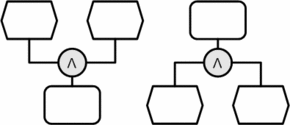
Connection Type: AND Connections EPC Example No. 2
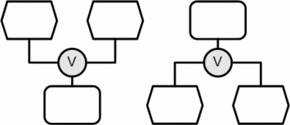
Connection Typo: OR Connections EPC Example No. 3
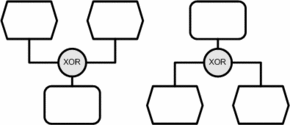
Connection Type: XOR Connections EPC Example No. 4
Table No. 3 - EPC Event Connections
Function Connections
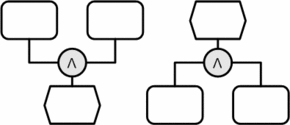
Connection Type: AND Connections EPC Example No. 5
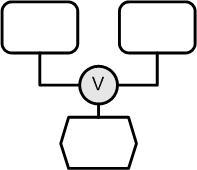
Connection Type: OR Connections EPC Example No. 6
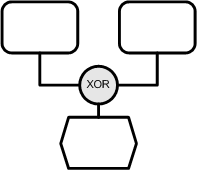
Connection Type: XOR Connections EPC Example No. 7
Table No. 4 - EPC Function Connections
Forbidden Function Connections
ATTENTION: As events cannot make decisions two function connections (OR & XOR) are missing in the table above. This means that two or more functions can follow one event (=AND) but one event cannot:
Cause one function and/or another function (=OR)
Cause either one or another function (=XOR)
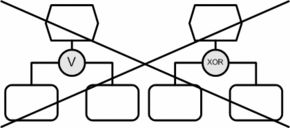
Figure No. 1 - EPC impossible Function
Combination between Alternative Connections
It is possible that the choice of functions depends on the (non) occurrence of a whole variety of possible events. The following illustrative example shows only one variant and cannot be considered exhaustive:
If event 1 OR event 2 occurs, function 1 AND function 2 start.
Data View
The final subsection deals with the integration of the data view into event-driven process chains:
Functions work on data as input data change to output data.
Functions produce events (data-state changes).
The graphic design of the integration of the data view is expressed by EPC models in the "broad form".

Expression of Data: Data Elements of Info Objects

Expression of Data: Organisational Units

Expression of Data: Info Objects (see Note)
Table No. 5 - EPC
Note: Info objects represent the means of processing a function.
